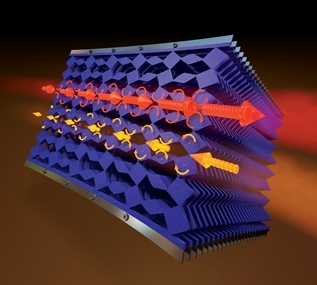Scientists have developed a material that breaks one of the fundamental principles governing many physical systems. Ordinary materials transmit external forces equally, no matter where the pressure comes from. The newly developed material breaks this rule and could potentially be of interest in soft-robotics or shock absorption related applications. The research team from AMOLF, Leiden University and the University of Texas at Austin published their findings on 13 February in Nature.
Reciprocity
The researchers’ breakthrough lies in the ability to overcome reciprocity in mechanics. Reciprocity governs how light, radio signals, sound and motion travel through materials. It ensures that when you are able to send a signal you can also receive it. Reciprocity also means that, if pushing a soft object on the left side results in moving the right side by a certain amount, we can expect the same motion at the left when pushing the right side.
The material
Corentin Coulais (AMOLF/Leiden University), Dimitrios Sounas and Andrea Alù (UT Austin) have developed the first kind of non-reciprocal material to break this rule. The material can transmit motion in one way and block it in the other. Coulais says: “We created and fabricated so-called metamaterials, which acquire their extraordinary behavior from their architecture: a flat rubber sheet patterned with carefully designed holes. Each unit in this design slightly leans rightward, which is an important feature to break reciprocity.
How does it work?

This picture shows a topological mechanical metamaterial that features large non-reciprocity: the right side moves when pushing on the left, but the left side moves much less when pushing on the right with the same force. Credits: Cockrell School of Engineering, The University of Texas at Austin
However subtle the metamaterial design may be, when put to the test, it exhibits drastically different responses. Applying pressure on the right side of the metamaterial easily induces motion within the structure, but only in the near vicinity of the pressure point and the effect on the other end is negligible. However, applying the same amount of force on the left side clearly has a much stronger effect as the motion propagates through the entire material. The researchers further discovered how to make the metamaterial sensitive enough to show non-reciprocal behavior even under minor pressure.
Towards non-reciprocal devices
“Non-reciprocal metamaterials are currently being applied to manipulate radio waves and optical communications devices, but have remained so far unexplored for mechanical motion,” Alù says. “Our research opens up new strategies to block or transmit vibrations and shocks depending on where they come from.” The non-reciprocal mechanical metamaterials could also be further leveraged for various applications, such as soft robotics, prosthetics and energy harvesting. The team is looking forward to explore ways to control the degree of non-reciprocity in real-time as the material is used for the application of choice.
Reference
Corentin Coulais, Dimitrios Sounas, Andrea Alù, Static Non-Reciprocity in Mechanical Metamaterials, Nature (2017), DOI: 10.1038/nature21044
Source: AMOLF